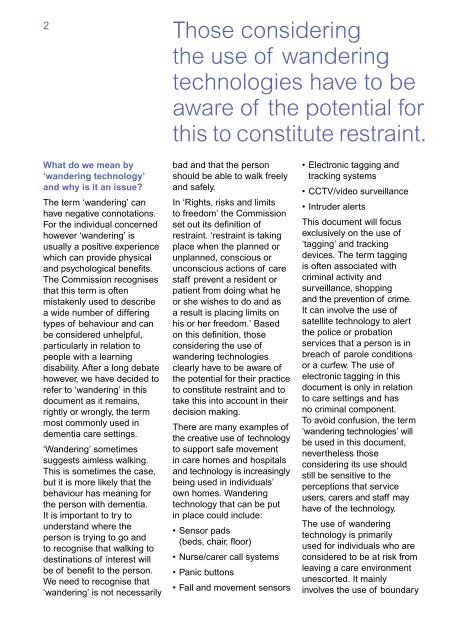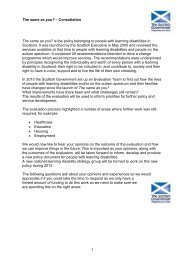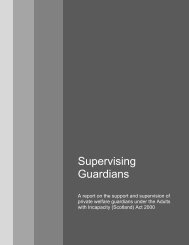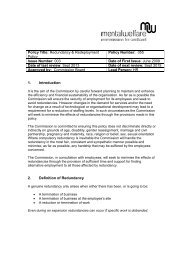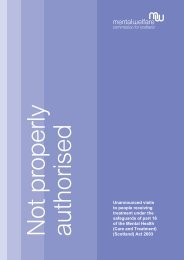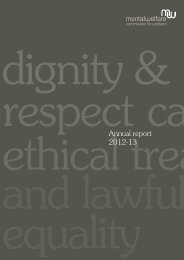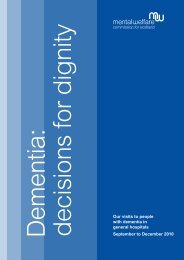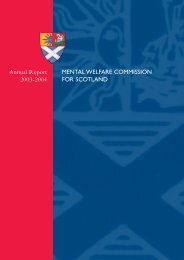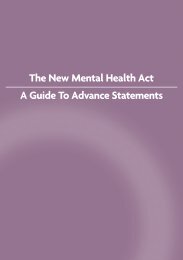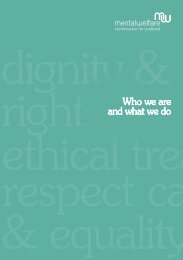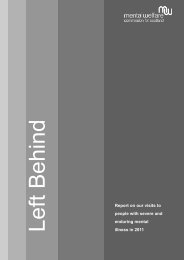Safe to wander - Mental Welfare Commission for Scotland
Safe to wander - Mental Welfare Commission for Scotland
Safe to wander - Mental Welfare Commission for Scotland
- No tags were found...
You also want an ePaper? Increase the reach of your titles
YUMPU automatically turns print PDFs into web optimized ePapers that Google loves.
2Those consideringthe use of <strong>wander</strong>ingtechnologies have <strong>to</strong> beaware of the potential <strong>for</strong>this <strong>to</strong> constitute restraint.What do we mean by‘<strong>wander</strong>ing technology’and why is it an issue?The term ‘<strong>wander</strong>ing’ canhave negative connotations.For the individual concernedhowever ‘<strong>wander</strong>ing’ isusually a positive experiencewhich can provide physicaland psychological benefits.The <strong>Commission</strong> recognisesthat this term is oftenmistakenly used <strong>to</strong> describea wide number of differingtypes of behaviour and canbe considered unhelpful,particularly in relation <strong>to</strong>people with a learningdisability. After a long debatehowever, we have decided <strong>to</strong>refer <strong>to</strong> ‘<strong>wander</strong>ing’ in thisdocument as it remains,rightly or wrongly, the termmost commonly used indementia care settings.‘Wandering’ sometimessuggests aimless walking.This is sometimes the case,but it is more likely that thebehaviour has meaning <strong>for</strong>the person with dementia.It is important <strong>to</strong> try <strong>to</strong>understand where theperson is trying <strong>to</strong> go and<strong>to</strong> recognise that walking <strong>to</strong>destinations of interest willbe of benefit <strong>to</strong> the person.We need <strong>to</strong> recognise that‘<strong>wander</strong>ing’ is not necessarilybad and that the personshould be able <strong>to</strong> walk freelyand safely.In ‘Rights, risks and limits<strong>to</strong> freedom’ the <strong>Commission</strong>set out its definition ofrestraint. ‘restraint is takingplace when the planned orunplanned, conscious orunconscious actions of carestaff prevent a resident orpatient from doing what heor she wishes <strong>to</strong> do and asa result is placing limits onhis or her freedom.’ Basedon this definition, thoseconsidering the use of<strong>wander</strong>ing technologiesclearly have <strong>to</strong> be aware ofthe potential <strong>for</strong> their practice<strong>to</strong> constitute restraint and <strong>to</strong>take this in<strong>to</strong> account in theirdecision making.There are many examples ofthe creative use of technology<strong>to</strong> support safe movementin care homes and hospitalsand technology is increasinglybeing used in individuals’own homes. Wanderingtechnology that can be putin place could include:• Sensor pads(beds, chair, floor)• Nurse/carer call systems• Panic but<strong>to</strong>ns• Fall and movement sensors• Electronic tagging andtracking systems• CCTV/video surveillance• Intruder alertsThis document will focusexclusively on the use of‘tagging’ and trackingdevices. The term taggingis often associated withcriminal activity andsurveillance, shoppingand the prevention of crime.It can involve the use ofsatellite technology <strong>to</strong> alertthe police or probationservices that a person is inbreach of parole conditionsor a curfew. The use ofelectronic tagging in thisdocument is only in relation<strong>to</strong> care settings and hasno criminal component.To avoid confusion, the term‘<strong>wander</strong>ing technologies’ willbe used in this document,nevertheless thoseconsidering its use shouldstill be sensitive <strong>to</strong> theperceptions that serviceusers, carers and staff mayhave of the technology.The use of <strong>wander</strong>ingtechnology is primarilyused <strong>for</strong> individuals who areconsidered <strong>to</strong> be at risk fromleaving a care environmentunescorted. It mainlyinvolves the use of boundary


